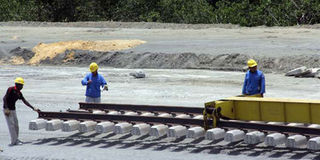Ministry, corporation and contractor say Kenya's railway is superior

Track laying underway for standard gauge railway in Kipevu, Mombasa on October 4, 2016. PHOTO | LABAN WALLOGA | NATION MEDIA GROUP
What you need to know:
- After comparing Addis Ababa–Djibouti standard gauge railway and its Mombasa-Nairobi counterpart, I concluded that the former was advantaged.
- Ministry of Transport, Infrastructure, Housing and Urban Development, Kenya Railways Corporation and China Road and Bridge Corporation disagreed.
Last week, I pointed out that the just-inaugurated electric-powered Addis Ababa-Djibouti standard gauge railway is longer than its diesel-driven Mombasa-Nairobi counterpart by 271 kilometres and yet it cost US$3.4 billion as compared to the latter’s budgeted US$3.6 billion.
I similarly reported that passenger trains on the Addis Ababa-Djibouti line will travel at a maximum speed of 160 kilometres per hour, with their freight counterparts clocking 120 kilometres per hour.
Kenya’s passenger and freight trains, I made it known, will cruise at 120 kilometres per hour and 80 kph respectively. I, therefore, raised questions about the cost of the Kenyan line and the viability of both. But concluded that advantage, as they say in tennis, Addis Ababa-Djibouti line.
The Ministry of Transport, Infrastructure, Housing and Urban Development, the Kenya Railways Corporation and China Road and Bridge Corporation, the contractors, disagreed. They all weighed in to explain the difference in cost. The main reason, they say, is the classification of the lines.
“The fundamental difference is the classification of the railways – Nairobi-Mombasa is Class 1 for high capacity freight volumes.” The Addis Ababa-Djibouti line is Class 2 on the Chinese railway classification. Therefore, the maximum load of each freight train on the Kenyan line will be 4,000 tonnes in double-stacked containers as compared to 3,500 tonnes for a single-stack goods train on the Addis-Djibouti line. The axle loading for the Kenyan line permits 25 tonnes as compared to 22.5 tonnes for the Ethiopia-Djibouti line.
‘PROTRACTED ACQUISITION’
Another reason, say the Government and contractor, is the “protracted land acquisition and demand by local people for underpasses for domestic animals” and vehicles. They did not reveal how much money has been used to compensate people affected by project, but my information is that this so far stands at above Sh30 billion. There is no private ownership of land in Ethiopia. Land ownership is exclusively vested by the constitution in the state and the people. Compensating landowners did not, therefore, arise in Ethiopia.
However, I would be remiss if I did not remind that on December 13, 2015, I reported that the compensation process in Kenya was described by Kenya Railway’s own draft audit report as a “catalogue of misuse, misallocation and downright abuse of public resources.”
Indeed, I also reported that on December 2, 2015, the parliamentary Public Investments Committee had called for a fresh audit of the compensation process and expressed fears that “taxpayers were losing billions of shillings to persons to whom land that previously belonged to Kenya Railways had been parcelled out.”
The cost difference is also explained by the fact that while in Ethiopia and Djibouti only railway stations are fenced off, the entire Mombasa-Nairobi line corridor will be fenced. Fourth, “the design and construction” of the Kenyan line “had to contend with numerous demands by locals for underpasses for domestic animals and vehicles.” And, Government and contractor report, underpasses were “provided at nine locations within Tsavo National Park and one location within the Nairobi National Park.”
POWER STATIONS
I think it is important to point out that while the Addis Ababa-Djibouti line may not have as many underpasses as its Kenyan counterpart, it does have a total of 20 power stations needed to provide traction power for the trains at 40 kilometre intervals. The concrete electric traction poles were, however, cast locally. Electrification is “reserved as one of the options for increasing line capacity in future should adequate power supply be adequate.”
Another reason given for the high cost of Kenya’s line is that the costs of labour and materials are higher in Kenya than they are in Ethiopia. Cement, for example, is twice as cheap in Ethiopia because the country has abundant supply of electricity. Kenya is also using specially made cement in keeping with the 100-year design life of its line.
The ministry, Kenya Railways and contractor also point to the fact that the signalling for Kenya’s line is automated because of the heavy traffic expected while the signalling for the line in Djibouti is semi-automatic which is suited for low traffic intensity. I have not as yet established whether the signalling in Ethiopia is automatic or semi-automatic.
In a word, the ministry, Kenya Railways and the contractor insist the Mombasa-Nairobi railway is superior to the Addis Ababa-Djibouti line and therefore not more expensive.





